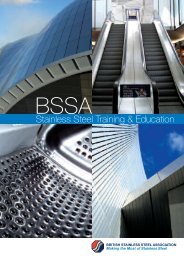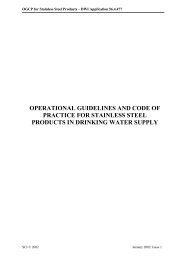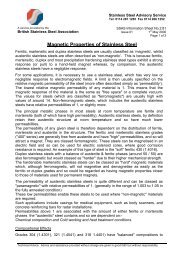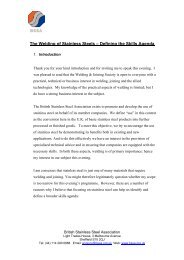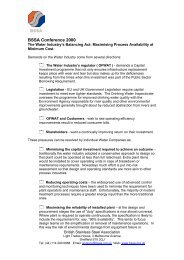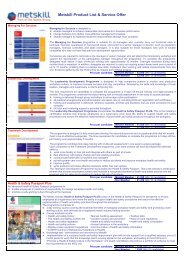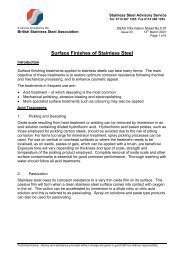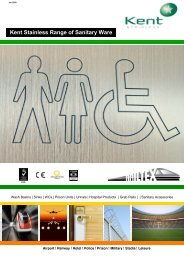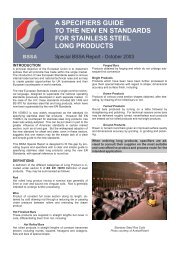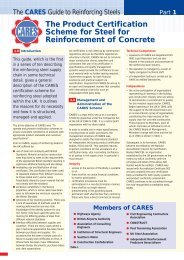The energy benefit of stainless steel recycling - British Stainless ...
The energy benefit of stainless steel recycling - British Stainless ...
The energy benefit of stainless steel recycling - British Stainless ...
Create successful ePaper yourself
Turn your PDF publications into a flip-book with our unique Google optimized e-Paper software.
ARTICLE IN PRESS<br />
J. Johnson et al. / Energy Policy ] (]]]]) ]]]–]]] 5<br />
<strong>of</strong> this study were close for ferronickel and significantly<br />
lower for refined nickel. Country-level production data<br />
were obtained from the International Nickel Study Group<br />
(2004).<br />
<strong>The</strong> <strong>energy</strong> required to produce DRI was estimated from<br />
seven production methods. Based on a weighted average <strong>of</strong><br />
each method’s global plant capacity, the average reductant<br />
and electricity use were determined to be 11.3 GJ <strong>of</strong> natural<br />
gas/ton DRI and 99 kWh/ton DRI, respectively (Oeters<br />
et al., 2006). Country-level production was taken from the<br />
International Iron and Steel Institute (2005).<br />
Data for <strong>stainless</strong>-<strong>steel</strong> electric arc furnaces were taken<br />
from Outokumpu (2006), who detailed use <strong>of</strong> electricity<br />
propane, carbon monoxide, natural gas, and fuel oil.<br />
Country-level <strong>stainless</strong>-<strong>steel</strong> production was taken from<br />
ICDA (2006). Scrap is processed and prepared using<br />
presses, shears, bundlers, cutting, and crushing, with most<br />
<strong>of</strong> the <strong>energy</strong> being used in the form <strong>of</strong> electricity. An<br />
analysis <strong>of</strong> six scrap-processing facilities yielded an average<br />
electricity consumption <strong>of</strong> 6.8 kWh/ton scrap.<br />
<strong>The</strong> <strong>energy</strong> requirements for transportation <strong>of</strong> all<br />
intermediate goods were also quantified. Matrices were<br />
created that detailed the mass <strong>of</strong> each intermediate good by<br />
the exporting country and the importing country, including<br />
chromite ore and concentrate (International Chromium<br />
Development Association, 2006), ferrochromium (International<br />
Chromium Development Association, 2006),<br />
blended and concentrated nickel ore (International Nickel<br />
Study Group, 2004), ferronickel (Kuck, 2005), refined<br />
nickel (International Nickel Study Group, 2004), nickel<br />
oxide sinter (International Nickel Study Group, 2004), iron<br />
ore and concentrate (United Nations Comtrade Database,<br />
2006) and DRI (United Nations Comtrade Database,<br />
2006). While there is certainly the potential for hundreds <strong>of</strong><br />
country-to-country exchanges, it was found that 95% <strong>of</strong><br />
the traded mass could be accounted for by less than 50<br />
exchanges per material. By assuming trade routes and<br />
means <strong>of</strong> transfer, the distances between the exporters and<br />
the importers were used to create an average distance<br />
traveled by each transport method. <strong>The</strong> collection and<br />
transportation <strong>of</strong> scrap is difficult to estimate with high<br />
certainty due to the high variability <strong>of</strong> transportation<br />
distances and the lack <strong>of</strong> detailed trade data. Discussions<br />
with experts in the scrap industry and internal calculations<br />
based on the distances between major scrap-generating<br />
areas, collection areas, and <strong>stainless</strong>-<strong>steel</strong> smelters have<br />
lead to travel estimates <strong>of</strong> approximately 180 miles by<br />
truck, 160 miles by rail, and 2100 miles by ship. Using EIA<br />
<strong>energy</strong> intensities (US Department <strong>of</strong> Energy, 2006), the<br />
<strong>energy</strong> consumed per ton-mile was applied and the <strong>energy</strong><br />
use was calculated. (Note: the transportation <strong>of</strong> fabricated<br />
<strong>stainless</strong> <strong>steel</strong> is not included in this study; the end goal <strong>of</strong><br />
this study is to calculate the <strong>energy</strong> requirements to<br />
produce 1 ton <strong>of</strong> <strong>stainless</strong>-<strong>steel</strong> slab and that is where the<br />
system boundary ends.)<br />
<strong>The</strong> results <strong>of</strong> mining, alloy production, scrap preparation,<br />
<strong>stainless</strong>-<strong>steel</strong> smelting, and transportation <strong>of</strong> intermediates<br />
were aggregated to determine the total primary<br />
<strong>energy</strong> used to produce 1 ton <strong>of</strong> austenitic <strong>stainless</strong> <strong>steel</strong>.<br />
<strong>The</strong>se results were then coupled with CO 2 emission factors<br />
(Energy Information Administration, 2006), which include<br />
linking country-level electricity generation data to emissions<br />
by source.<br />
<strong>The</strong>re are many inputs to this model and all values<br />
contain a degree <strong>of</strong> uncertainty. In order to assess this<br />
uncertainty and variability, a Monte Carlo analysis was<br />
performed. A probabilistic method, such as a Monte Carlo<br />
analysis, provides more information than deterministic<br />
models, giving a range <strong>of</strong> results linked to their likelihood<br />
(McCleese and LaPuma, 2002). For each <strong>of</strong> the variables,<br />
including <strong>energy</strong> demands, material losses, transportation<br />
distances, scrap concentrations, and metal sourcing, an<br />
estimate was made <strong>of</strong> the uncertainty <strong>of</strong> the data. <strong>The</strong>se<br />
estimates were based on data variability and assumed<br />
confidence in their accuracy, with normal distributions<br />
around the weighted mean applied. Dependant variables<br />
were linked and 400 simulations were then run for each<br />
scenario to determine the range and distribution <strong>of</strong> the<br />
results.<br />
<strong>The</strong> model’s sensitivity to changes in each <strong>of</strong> these<br />
variables is also important. Forty-three <strong>of</strong> the variables<br />
included in the analysis were increased by 25% to examine<br />
the effect on the total primary <strong>energy</strong> <strong>of</strong> the Current<br />
Operations scenario.<br />
3. Results<br />
<strong>The</strong> <strong>energy</strong> used at each production process is underpinned<br />
by the amount <strong>of</strong> material that is required. Fig. 2<br />
details the material flows <strong>of</strong> chromium, nickel, and iron in<br />
the production <strong>of</strong> 1 ton <strong>of</strong> austenitic <strong>stainless</strong> <strong>steel</strong> under<br />
each <strong>of</strong> the three scenarios. <strong>The</strong> material flows shown in the<br />
figures represent the contained mass <strong>of</strong> the elements in each<br />
flow. For example, the flow into chromium mining for<br />
Current Operations (Fig. 2a) is 146 kg <strong>of</strong> contained<br />
chromium in ore; the total mass <strong>of</strong> the chromite ore is<br />
estimated to be 490 kg, a value that is not shown in this<br />
figure. It should also be noted that the iron contained in<br />
ferrochromium and ferronickel was not quantified for<br />
stages prior to alloy production (i.e., during the mining<br />
processes for chromium and nickel) and, therefore, is not<br />
shown in the figure.<br />
In order to achieve material balance for each <strong>of</strong><br />
the elements, the amount <strong>of</strong> austenitic, ferritic, and<br />
carbon <strong>steel</strong> scrap that is recycled has to correspond with<br />
<strong>recycling</strong> rates and material loss flows. In Fig. 2a, this<br />
constraint meant that only austenitic <strong>stainless</strong>-<strong>steel</strong> scrap<br />
and carbon <strong>steel</strong> scrap were included, so as to not have an<br />
overabundance <strong>of</strong> secondary chromium units that would<br />
have come with ferritic <strong>stainless</strong>-<strong>steel</strong> scrap <strong>recycling</strong>.<br />
Because it is known that ferritic scrap is included in actual<br />
production, this is a limitation <strong>of</strong> the material flow data<br />
and could be updated to improve the accuracy <strong>of</strong> this<br />
study.<br />
Please cite this article as: Johnson, J., et al., <strong>The</strong> <strong>energy</strong> <strong>benefit</strong> <strong>of</strong> <strong>stainless</strong> <strong>steel</strong> <strong>recycling</strong>. Energy Policy (2007), doi:10.1016/j.enpol.2007.08.028



